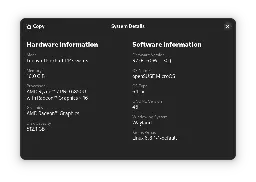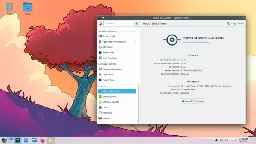Search
March has been an exciting month for openSUSE Tumbleweed users as GNOME 46 made its way into the rolling release like KDE’s Plasma 6 did a few weeks ago. The...

March has been an exciting month for openSUSE Tumbleweed users as GNOME 46 made its way into the rolling release like KDE’s Plasma 6 did a few weeks ago.
The GNOME users and developers not only get the upgrade in the rolling release but in the Aeon Desktop derivative. The release in the Slowroll distribution will likely see an update between April 2 and April 14.
GNOME’s version 46 codenamed “Kathmandu” pays homage to the contributions from GNOME.Asia 2023 organizers and has significant improvements and new features. A standout feature in GNOME 46 is the new global search functionality within the files app. This feature enables users to search across all configured locations directly and an addition of filters by file type and modification date further refine the tool.
The files app had a major revamp that allows for instant view switching between list and grid modes. It also had some other minor improvements such as enhanced network discovery and starred favorites in grid view, which amplified file management efficiency.
A new remote login option enhances GNOME’s remote desktop capabilities, which allows for improved configuration and user experience from the remote side.
Accessibility has seen significant advancements, especially with the Orca screen reader, which now includes a new sleep mode and system status reports. Additionally, there’s an increase in high contrast mode consistency and new settings for clearer switch toggling.
Other changes include the settings app, which has been reorganized and was updated for easier navigation. The new touchpad settings is noteworthy and includes configurations for secondary clicks that aims to enhance user interaction and convenience.
System updates include refreshed user avatars, improved notifications, and tap-to-click enabled by default. The Software app now features verified badges for Flathub apps, and both the extensions and calendar apps have been redesigned for better usability and aesthetics.
Beyond user-facing features, GNOME 46 introduces deep technical enhancements. These include performance and resource usage optimizations, security enhancements, rendering improvements and experimental support for variable refresh rates to improve video performance under certain conditions.
With its comprehensive updates and new features of GNOME 46, people should either be doing a zypper dup or transactional-update to get the latest.
More Information about openSUSE:
- https://news.opensuse.org/
- https://discuss.tchncs.de/c/[email protected]
A lot of excitement was brewing at the announcement of KDE’s Plasma 6 release and now the MegaRelease has arrived in openSUSE Tumbleweed and Kalpa while plan...

Plasma Arrives in openSUSE’s Releases
22. Mar 2024 | Douglas DeMaio | CC-BY-SA-3.0
A lot of excitement was brewing at the announcement of KDE’s Plasma 6 release and now the MegaRelease has arrived in openSUSE Tumbleweed and Kalpa while plans for Slowroll are progressing.
Rolling release users and the developer community get an upgrade that marks a monumental shift for KDE desktop users. The update will make it into a Slowroll release in April as the distributions steady paced version-bumps are expected between April 2 and April 14.
Almost a decade from the release of Plasma 5, the desktop experience for Plasma 6 begins. The transition not only signifies an advancement in aesthetic and functionality, but also underscores openSUSE’s commitment to providing this highly anticipated technology to its users.
Plasma 6 introduces a ton of improvements and features that cater to a diverse array of users; from the tech-savvy enthusiast to the casual user. The update sees major changes under-the-hood as a transition to the latest Qt application framework and migration to the Wayland display server protocol that is set to be the default graphical session. At this time however, It’s important to note that the Wayland session is not yet the default in Tumbleweed; this decision allows users and developers to discern whether encountered issues stem from Plasma 6 itself or the Wayland session. Tumbleweed’s KDE desktop derivative Kalpa plans switching to Wayland by default.
Developments include enhanced security, performance and improved modern hardware support.
Despite these significant changes, users are expected to find the Plasma 6 environment familiar, retaining the classic KDE look and feel while laying the groundwork for future innovations.
The new release boasts features such as an overview and desktop grid effects; It improves the touchpad gestures, and partial High Dynamic Range (HDR) support on Wayland, which, combined with the new ‘Scarlet Tree’ wallpaper, transforms the desktop into a vibrant and dynamic workspace.
Plasma 6 introduces changes aimed at enhancing user experience, including a shift in default settings. Notably, it adopts a single-click action for selecting files and folders and a double-click action for opening them. While the single-click approach streamlines the opening process, it may be less intuitive for users accustomed to other systems and could complicate the selection of multiple items. The double-click, however, is more familiar to those migrating from different systems and provides known usability when selecting items.
While the transition to Plasma 6 promises an array of benefits, a few minor issues have been identified in the snapshot. None were deemed severe enough to delay its release.
These known topics include:
- GTK theme setting for new Installations: Some users may find the GTK theme is not set correctly. A workaround involves manually setting it in system settings or running “kded5” once.
- Launcher icon switch for upgrades: Users upgrading their system may notice the launcher icon defaults to the Plasma icon. This can be adjusted manually by changing the icon to “start-here-branding.”
- Upgrades from Older Systems: A known issue affects users upgrading from Leap versions 15.3 or older related to a package called “libksysguard5-helper.” The recommended solution is to opt for deinstallation of the problematic package.
- Plasmashell start delay: Users without Bluetooth hardware may experience a delay in Plasmashell start-up if kdeconnect-kde is installed, which can be mitigated by disabling the KDE Connect system tray icon.
As openSUSE continues to evolve with Plasma 6, Tumbleweed, Kalpa and Slowroll remain dedicated to delivering a fresh, stable and updated systems to the global open-source community.
The openSUSE KDE packaging team encourages users to embrace this new phase, explore the rich features of Plasma 6 and provide feedback to help refine future releases. The adventure is just beginning for Plasma 6 and we invite people to engage with the development of open-source software and to “have a lot of fun” on this journey into a new era of desktop computing.
More Information about openSUSE:
- https://news.opensuse.org/
- https://discuss.tchncs.de/c/[email protected]
Updates and Dependency Hell
Hi,
I'm in the weird spot again, where I want to update my Tumbleweed system and am lost in a dependency hell. It more or less occurs once in a while when updates drop and the prompt asks if I want to install stuff from vendor "obs://build.opensuse.org/home:wolfi323" replacing the obsolete stuff from the official openSUSE vendor.
As soon as I read wolfi323, I get fucking Vietnam flashbacks, because it means I will have to decide for ~100 services if I keep the current obsolote version or install the one from wolfi323. Either way, it's gonna fuck up a myriad of dependencies.
All that hassle just to do the same shit all over again because at some point, the official opensuse repos catch up with newer versions.
I could probably wait for the official updates, but it's uncertain, when they are going to drop and I'll just pile up thousands of updates in the meantime.
How do the Tumbleweed Folks among us deal with this?